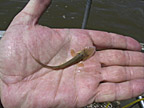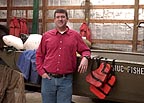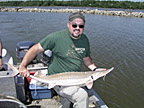November 06, 2006
Scientist fears collapse of river sturgeon population
CARBONDALE, Ill. -- James E. Garvey is alarmed when he examines his data on sturgeon living in the Mississippi River.
For the last six years, the Southern Illinois University Carbondale associate professor has studied the fish, tracking its movements, identifying its habitats and estimating its mortality rate. Garvey, who works with the Fisheries and Illinois Aquaculture Center at SIUC, has received more than $2 million in grants to fund his studies on the Mississippi River since arriving at the University.
There is a reason for his interest: The sturgeon, whose fierce, bony appearance betrays its prehistoric roots, is highly prized by commercial fish operations for eggs — caviar —that are large and plentiful in adult females.
Ever since overseas beluga sturgeon populations crashed, prompting the United States to restrict caviar imports, demand for Mississippi River shovelnose sturgeon eggs has soared. A mature female can yield about a half-pound of eggs, which in turn can fetch prices of $300 an ounce, creating a strong incentive for those whose livelihoods depend on bringing the delicacy to market.
Garvey considers it his job to find the best ways for humans to use fish as a resource and often works with sturgeon fishing operations while conducting research.
What concerns him now, however, is that populations of domestic sturgeon such as the shovelnose and the more rare (and federally endangered) pallid variety are reaching a critical point.
"The harvest, during the last two or three years, has been increasing exponentially," said Garvey, whose research is funded by the U.S. Army Corps of Engineers.
"It's been very unregulated."
He's trying to sound the warning.
"My fear is that we are right now at a point where we're watching the population at a stage when it might collapse, and that can happen very quickly," he said.
Garvey's research focuses on several aspects of the sturgeon's life, including their typical location in the river and their preference for water flow rates.
It started with telemetry work in which Garvey and graduate students worked with fishing operations to catch, tag and release sturgeon and then track their movements using the ultrasonic squawks emitted by the tags. This led to revelations about their feeding habits.
It turns out they're predators who use river currents as a sort of cafeteria. As the fish-laden current sweeps by, the sturgeon pick off all the "entrees" they want.
The research also has revealed mortality rates, which Garvey said have increased greatly among the mature, breeding-age fish that typically sustain the overall population.
Four years of data indicate the mortality rate for the sturgeon has risen to about 25 percent, meaning a mature fish has a 25 percent chance of dying in any given year. Typically, such indicators can rise a good deal before they affect the overall population. Garvey said his data show that is starting to happen.
"For the first time, we're starting to see the number of young, juvenile sturgeon declining," Garvey said. "This means for every increment the mortality rate increases in the mature population, we'll see an equal effect in the juvenile population."
Not only are sturgeon numbers as a whole declining, but the federally endangered pallid sturgeon — slightly larger and paler than the shovelnose — also are being taken as fishing operations' gill nets make no distinction in what gets caught in the webbing. Garvey said his research indicates pallid sturgeon are dying at about the same rate as the shovelnose.
"They look a lot alike, and when they're younger it's very difficult to tell them apart from the shovelnose," Garvey said.
"Also a mature pallid is a little larger, which means it has more eggs. There's a lot of evidence that they're being harvested as well."
To prevent harvesting, Garvey said states bordering the Mississippi need to enact new, tough regulations on catch limits. He wants to protect the fish as a long-term resource for the fishing operations, instead of having the population collapse as it did overseas when harvesting went unchecked.
"I understand it's a balancing act and I'm in fisheries, which by definition means I look at ways to help humans use fish as a resource," Garvey said. "But we want to make sure we utilize the resource in a wise and sustainable way. The data show that what the population needs now are some really good regulations, or even a temporary closure."
If the population collapses, the effects might be disastrous.
"There's the obvious economic impact on the fishing industry," Garvey said. "But there's also the ecological. With a lot of species, we don't know what role they play in the system until they're gone.
"Also, there's the simple aesthetic value of having the sturgeon around. This is a fish that has been around essentially since the dinosaurs."
Garvey would like some efforts focused on restricting harvesting at the Chain of Rocks area near St. Louis. Conditions there appear to appeal to sturgeon, and fishing boats tend to do very well there during spawning season, he said. He said the area presents a perfect opportunity to create a wildlife sanctuary and education center.
Garvey said the Corps of Engineers is funding his work because it is willing to enhance sturgeon habitat wherever possible while pursuing its main goal of keeping the waterways navigable for barge traffic. Garvey said he wants to protect the species for future generations of fishermen and naturalists.
"I was skeptical (about a population collapse) for the last few years, but all the warning signs are there," Garvey said.
Identifying, pursuing and obtaining new sources of external grant and contract funding and sustaining partnerships with business and industry are among the goals of Southern at 150: Building Excellence Through Commitment, the blueprint the University is following as it approaches its 150th anniversary in 2019.

Just a baby – An immature
shovelnose sturgeon sits in
the hand of a researcher
from Southern Illinois
University Carbondale, after
being caught for study on the
Mississippi River recently.
SIUC Associate Professor
James E. Garvey is concerned
about the fish’s dwindling
numbers as fishing operations
catch it for its eggs, which
are marketed as caviar.
Download Photo Here

Sturgeon researcher – Southern
Illinois University Carbondale
Associate Professor James E.
Garvey is concerned about the
dwindling numbers of sturgeon
in the Mississippi River as
fishing operations catch the
fish for its eggs, which are
marketed as caviar. Garvey
works at the Fisheries &
Illinois Aquaculture Center
at SIUC. Download Photo Here

What a catch – Southern Illinois
University Carbondale doctoral
student Rob Colombo, of Suffern,
N.Y., holds a mature pallid
sturgeon caught during a
University study on the
Mississippi River. Suffern is
the son of Robert and Audrey
Colombo (10 River Road). He
is part of a University
research team, led by SIUC
Associate Professor James
E. Garvey, studying the
effects of commercial harvest
on the fish. Garvey is
concerned about the fish’s
dwindling numbers as fishing
operations continue to
harvest it for its eggs,
which are marketed as caviar.
Download Photo Here
